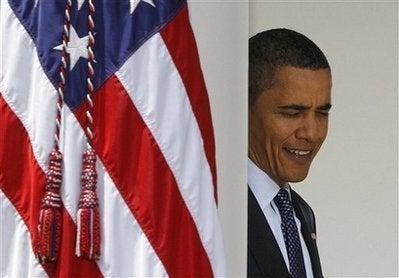
President Barack Obama has hosted at least 27 meetings with some of the most influential private health-industry executives in the country in an effort to placate or at least quiet potential opponents of reform in what remains a tenuous legislative process.
Under pressure from a good-government organization, the White House released on Wednesday evening the names of industry officials whom the president has met and the dates of their meetings. The records show that, from early February to late June, the White House has invited 15 of the health care and pharmaceutical industry's most powerful players.
The president's meetings were handed over to the good government group Citizens for Responsibility and Ethics in Washington, which had filed a lawsuit seeking the information. But the disclosure came roughly 50 minutes before the president hosted a prime-time news conference on the topic of health care reform. And the White House communications team reached out to the press corps about their plans for releasing the records several hours before they ever touched base with CREW, an official with the group confirmed. In short, the timing and process seemed geared towards diminishing the story's coverage.
Nevertheless, the names and dates provide a window into how wide a net the president has cast in his efforts to bring all parties to the table and craft health care reform. Many meetings involved a group of industry executives coming to the White House together.
- PhRMA President and CEO Billy Tauzin visited the White House on March 5, May 19, June 2, and June 24.
- Karen Ignagni, president and chief executive officer of America's Health Insurance Plans, visited the White House on March 5, 6, and 11 and June 30.
- Richard Umbdenstock, the president and chief executive officer of the American Hospital Association, visited the White House on February 4, February 23; March 5, March 25, March 30; April 6, and May 22.
- Dr. James Rohack, who is president of the American Medical Association visited the White House on March 25, June 22, and June 24. The latter two visits came less than two weeks after the AMA said it would oppose a public plan for insurance coverage. The group has since retracted its position.
The back story behind the Wednesday afternoon records release may be as fascinating as the records themselves, providing a small window into how the White House handles an unfavorable story on a sensitive subject.
On Wednesday morning, the Los Angeles Times published a story revealing that the Obama White House was refusing to release records of meetings it had allegedly held with 18 private health care industry executives (the number ended up being 15). Later in the day, CREW filed a lawsuit against the Department of Homeland Security seeking to obtain those records.
The story was politically damaging. As pointed out by Josh Orton at the site MyDD, Obama's campaign website still lists his pledge to do away with excessive government secrecy. And in an interview with the Huffington Post, CREW's chief counsel, Anne Weismann, declared that Obama's refusal to release the names of health care executives mirrored the much-maligned, closed door energy policy task force led by former vice president Dick Cheney.
"People wanted to know who Cheney had met with in formulating the Bush administration's energy policy and we want to know who the Obama administration met with in formulating their energy and now their health care policy," said Weismann. "It is all the more critical considering the debate going on right now and the push to get health care done quickly. I don't know if you can actually distinguish the two [Cheney's energy task force and Obama's health care meetings]."
Taken alone, the remarks were a sharp blow to a president who, throughout the campaign, used Cheney's secret task force meetings to denounce cryptic, special-interest-driven policy making of the Bush years. More broadly, however, they reflected what is an emerging frustration among government watchdogs about the failures of the Obama White House to achieve the transparent governance that the president promised on the campaign trail. This past week the special inspector general for the TARP testified that the Treasury Department had refused to adopt even the most rudimentary reforms to help track the spending of taxpayer funds.
Through it all, the White House insisted that it was operating within the letter of the law. The records, aides said, were exempt from public disclosure laws because they regard presidential communications. Moreover, they hinted that the administration was still in the process of setting disclosure policy and could end up reversing course in its decision to keep the records private.
In the end, the reverse was not a full one. While the White House did release the visitor logs, there was no promise that a new policy of disclosure had been implemented. In a letter to Weismann, the president's chief counsel, Greg Craig wrote:
...[T]he legal status of White House visitor records is the subject of ongoing litigation and that the White House is reviewing its policy governing the discretionary release of such records."
"There is no more important issue than health care reform, and the President is fully committed to helping Americans live healthier lives, preventing illness, and increasing the competitiveness of our country. Given the compelling public interest in the health care debate and the President's goal of increasing transparency in government, we have reviewed the White House visitors records related to the eighteen individuals listed in your request through June 30, 2009. The President has decided to exercise his discretion and release the following information, which is reflected in the relevant visitor records.
Here is the letter to Weismann from Craig:

